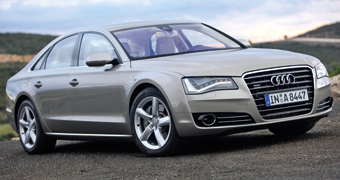
NEW YORK – Every market in which Audi sells vehicles today is growing at a pace that is in the double digits, says Peter Schwarzenbauer, member of the board of management in charge of global sales and marketing.
“Greece is the only market that is below our sales forecast,” he tells Ward’s in an interview here. “That’s because of the (poor) economy there. Every other market is performing better than previously.”
Audi’s shipments to the U.S have risen about 15% from year-ago, and, on a percentage basis, Argentina and Brazil are doing even better. “But we cannot build a limitless supply of cars,” Schwarzenbauer warns.
China is Audi's biggest overseas market, with sales trailing barely 1,000 units behind the auto maker’s German home market last year, he says. Audi sold 229,000 cars in Germany in 2010 and 228,000 in China. However, the U.S. remains the largest importer of completely built-up Audi vehicles.
Most Audis sold in China are assembled there, largely from parts shipped from Germany. The auto maker’s plant in China has a nominal capacity of 280,000 units annually. “We produce the A4, A6 and Q5 there,” Schwarzenbauer says. European-built vehicles account for the rest of Audi sales in China.
Audi sells the long-wheelbase A4 and A6 versions only in China, as many customers there employ chauffeurs.
Schwarzenbauer is dubious about a bubble being created in China. He says car ownership is only 27 per 1,000 inhabitants, compared with 800 per 1,000 in the U.S. “Currently, I see a very optimistic future for our company (in China).”
The German luxury-car maker’s global sales jumped to 1,092,411 units in 2010, compared with 950,000 in 2009, its marketing chief says. The U.S. growth rate was even higher than the overall world market.

Audi maintains a sales office in Miami to serve the Latin American market, excluding Argentina and Brazil. The Florida branch sells about 6,000 units annually to Chile, Columbia and Peru, as well as other countries in the Southern Hemisphere.
Schwarzenbauer admits U.S. dealers are concerned about supply constraints. “That’s the best problem we can have,” he tells them. “Call me every day about the short supply.”
Audi dealers could sell more vehicles if demand could be met, he admits, but insists deliveries are growing at a good rate. “My job is to make sure the U.S. gets the production it needs.”
Audi is not hesitating to export vehicles to the U.S., despite the weak dollar. “The U.S. economy creates such a big market, and it is still our biggest importer of fully built cars. “We look at the long-term situation.”
Nevertheless, global economies are recovering much more quickly than Audi planned for, Schwarzenbauer says. “There are boom markets around the world.”
To meet growing demand, Audi is scheduled to increase capacity in Germany this summer to achieve a more balanced supply to overseas markets.
The U.S., for instance, will get more vehicle deliveries in the second half of this year. “All of our factories are operating at full capacity,” he says.
Production of the Q3 cross/utility vehicle will start this summer with two shifts. The Q5 factory is operating at full capacity with three shifts, and the Q7 plant is at full capacity with two shifts.
The auto maker is not considering cutting its allotment to the U.S., even though the brand lags its German competitors in average transaction prices. That’s due to the fact Audi sells a much richer mix of vehicles in Europe than here, Schwarzenbauer says.
“Audi was No.1 in (transaction prices) in 2010 and also after the first quarter in Europe,” he claims.
The recently introduced A8 will help raise the brand’s average transaction price here, but not enough to catch BMW and Mercedes-Benz, Schwarzenbauer admits. On a global basis, Audi will rank No.2 in luxury-segment sales this year, trailing BMW by about 50,000 units.
The luxury segment will continue to grow at a higher rate than the mass market because wealth in the world is growing, he says. There were 4.1 million luxury vehicles sold in 2010, and Schwarzenbauer forecasts more than 7 million will be sold annually by 2020.
The electric-vehicle market will not be ignored. Some 5%-20% of Audis will come with electric plugs by 2020, he predicts.
“It depends on government incentives,” Schwarzenbauer says. “Manufacturers incur additional costs for building full electric cars that consumers are not willing to pay for. Consumers will only buy electric cars if they see an economic advantage.”


